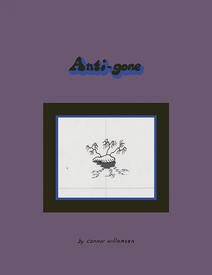Reviewed by Sam Ombiri.
Anti-Gone by Connor Willumsen (Koyama Press, 2017) is a really, really fantastic comic. It is horrifically insane. There’s such focus on the emotional responses of consumers that I got a kind of vertigo from it all. In fact, at the beginning of the comic I related to Lynxa throwing up from seasickness – it was that intense for me.
To me the comic has a horrifically calm space where everything is desperately made to be as satisfactory as possible. The twist in this case is that we don’t see the desperation – the ideal environment is rendered without any question.
When reading the comic the environments felt sudden, but rhythmically so – it was so deeply preoccupied with the rhythm in it’s sequencing to the point where it felt like me holding the book in my hands was just as much a matter of rhythm as Connor transitioning from one panel to the other.
This is true too of the various enviroments’ sudden appearances, at the service of rhythm. These places feel somehow alive, and this serves to really solidify the nature of the purchases made – which further displays the emotions evoked through transaction; and it’s real. Everything feels all too real! This book is the world we live in.
Connor, at least from my vantage point, isn’t interested in the negative aspects of being forced into just being a consumer; he treats the negative aspect as a given, and works from there. He is then, through the comics form, redesigning the world to his liking, in the sense that he shows us what he’d like to see. Or to be more specific, how he sees what he’d like to see. He does it through his superb cartooning, sequencing, and such.
The book boldly attempts to pinpoint the emotional impacts that are ordinarily obscured, often despised or purely intellectualized as opposed to being felt when presented to us – the public. Well, how could it be felt? Maybe it’s because of my ignorance, but I’m not aware of another comic that has struck this specific nerve so precicly, and so amazingly.
After reading Anti-Gone I got the feeling that if Connor was staring at the sun, he’d sooner describing the beauty of being blinded by the sun than the beauty of the sun itself. He’d be extensively designing a space in which he’s able to display the beauty of being blinded by the sun.
Connor’s art often is making that which is seemingly mundane or ugly beautiful; he redsigns what appears to be ugly and mundane and turns it all beautiful. Even when drawing something grotesque, Connor will simultaneously communicate the subject or object or scenario as grotesque and to what capacity something’s grotesque, but it’s done beautifully. So then whatever the ugly/grotesque thing is, it’ll have beauty in it. Then we as the readers, through Connor’s cartooning, can see what he finds beautiful in the midst of ugliness, and feel that sense of beauty he has discovered. Or in the case of Anti-Gone, where we are forced by the circumstances we live in to find beauty in the fact that we have to be consumers.
What’s so exciting to me about Anti-Gone is that it doesn’t demand that I be excited about the various things it’s doing or accomplishing. For example, there’s was an incredible moment at the beginning of Anti-Gone that didn’t call any attention to itself, where on the last panel of the physical page Lynxa flips a page in the drawing and then we the readers flip the page, as if to certify something with a lot of feeling as opposed to a detached sequence in which something of this nature transpires.
With this book Connor has really made the reader – with the dialogue, with the cartooning, with the sequencing – free to explore this space, and it’s just amazing to read.
